
The Great Stack of Handa Island
By Marg Greenwood
 The Great Stack of Handa Island, Sutherland
The Great Stack of Handa Island, SutherlandImage provided by Marg Greenwood
 The Great Stack of Handa Island, Sutherland
The Great Stack of Handa Island, SutherlandImage provided by Marg Greenwood
On the Sutherland coast, at Tarbet, I boarded a RIB with eleven others, soon landing on Handa, a tiny uninhabited island about five miles in circumference. It is maintained by the Scottish Wildlife Trust.
The Torridonian sandstone cliffs at the ocean coast of Handa drop precipitously into the sea. As I approached them I was almost deafened by the shrieks of thousands of seabirds crowding cliff ledges and flying distractedly around - razorbills, guillemots, kittiwakes, fulmars, shags, puffins and more.
The Great Stack, a high column of rock, stands only a a giant's leap from the neighbouring cliff. Standing 115 metres high, the stack is balanced on three legs and separated from the island by a gap which is only 24 metres wide. It has a grassy flat top, devoid of nests of any kind, most birds preferring to nest in the cliff ledges.
According to one source, in 1877 two men and a boy were commissioned to remove scores of black-backed gulls who were nesting on top of the stack and causing havoc- including predating other birds and chicks. The men tied one end of a long rope firmly near the cliff edge, and threw the rope over to the top of the stack 'which became sufficiently engaged on the stack' to allow the boy to scramble across - a mind-blowing feat. He then secured the rope safely enough for the men to follow him. (AA McGregor, Islands by the Score).
A slightly different account of this crossing makes no mention of the boy - 'Macdonald of Lewis made the first recorded crossing from the clifftop on Handa to the flat top of the Stack by swinging hand-over-hand from a rope.' (Hamish Haswell-Smith, An Island Odyssey.) Again in the 19th century, a similar stack, on the Cradle Holm of Noss in Shetland, was accessed by rope for the same reason. The gulls were killed off, but they returned in full force years later. (Their presence is now diminishing
Whoever, man or boy, first swung across the chasm by rope without being able to fasten it totally safely, was taking quite a risk.
Incidentally, gulls have never returned to nest on the grassy top, and it remains pristine.
The Stack was, eventually, first climbed from the sea below only in 1969. Another mind-blowing feat.